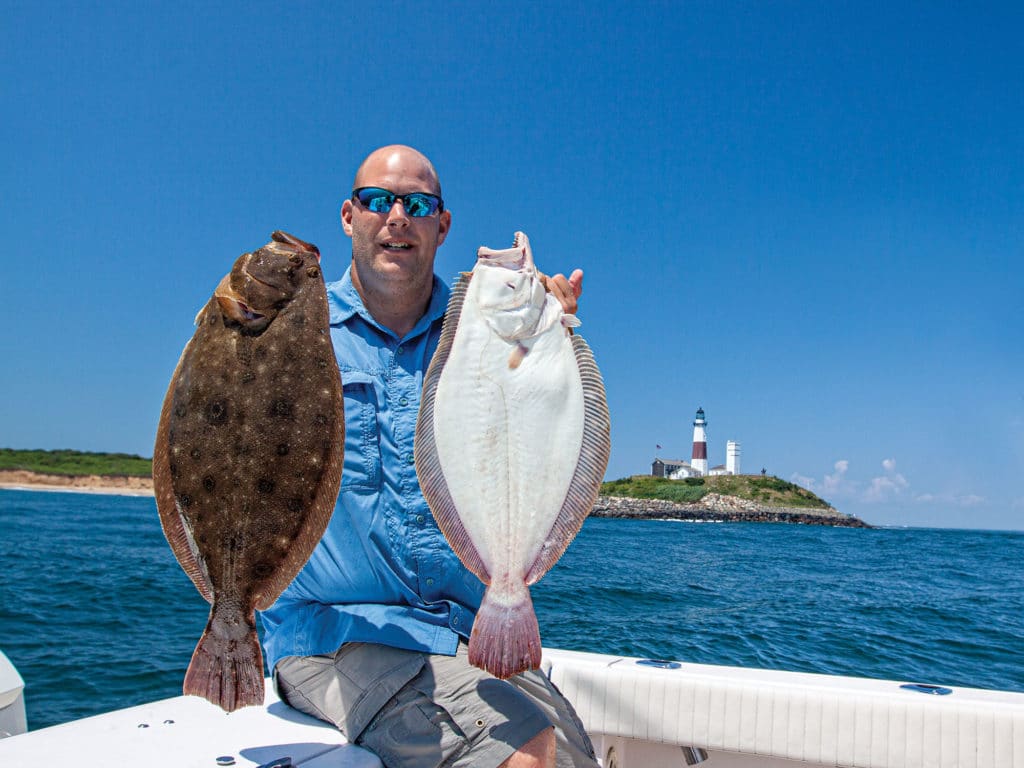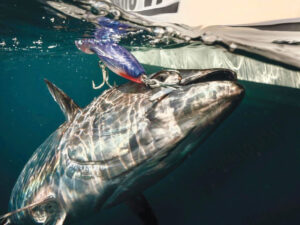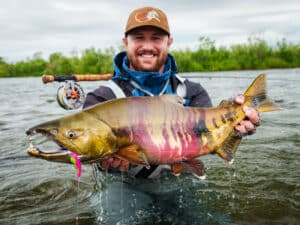
Capt. Marco DeStefano flipped his landing net upside down and spilled a 6-pound summer flounder onto the deck with a solid thud. Sliding smoothly across the stern, he immediately slipped the net under a second solid keeper and lifted it aboard. As anglers Bernie Reynolds and Mike Owens exchanged high-fives before quickly unhooking their catches and returning their rigs to the bottom, I realized I had witnessed this scene before.
Only last summer, the pair had put me to shame when it came to hauling big fluke from the hallowed doormat waters south of New York’s Montauk Point. In the words of the great Yogi Berra, it was “deja vu all over again,” leading to the kind of day that makes you glad you agreed to pool fillets.
Although neither would ever tell you so, Reynolds, 68, a retired Xerox field technician, and Owens, 74, a retired school administrator, are bona fide fluke experts. DeStefano (montauk-charters.com), 38, is an experienced skipper who knows how to put his customers on the fish. All three excel at deepwater, light-tackle fluke fishing.

“It’s hard to beat Montauk for big fluke because it has so many factors in its favor,” DeStefano says. “There’s plenty of hard bottom and structure here, which is what the biggest fluke have favored in recent years. There’s deep, cool water within a half-hour of port, and plenty of doormat bait, like squid, spearing, sand eels and bunker. A lot of guys can haul a limit here with some impressive flatties mixed in, but Bernie and Mike are among the best. A big part of their success comes from fishing as light as possible given the conditions, which makes for a ton of fun on my boat, since that’s how I most enjoy fluking too.”
Light indeed. While most serious Montauk fluke fans drag baits and bucktails on conventional gear with 20- to 40-pound-test line and 6- to 8-ounce sinkers, this trio targets flatties with light spinning or low-profile conventional gear, braided lines in the 10- to 20-pound class, and 2- to 4-ounce -bucktails or weights.

“Really, the point of using lighter line for fluke is that the thinner the diameter, the less resistance it has in the water,” Owens says. “That equates to less weight needed to get your bait to the bottom, the ability to make your jig dance more enticingly, and greater sensitivity when it comes to detecting any strikes.”
DeStefano likes that logic, noting that it’s important to not only get down to the bottom, but also keep your line as vertical as possible. The best way to accomplish that, he reasons, is to use braided lines, eliminate snaps and swivels from rigs, and select jigs and baits that are as streamlined as possible.
While the three fish similarly at first glance, their gear is slightly different, and each has his own techniques. Owens’ favorite outfit for this specialized fishing is a Van Staal PS50 -spinning reel spooled with 10- or 12-pound-test Spiderwire Ultracast Invisi-Braid line with an 18- to 24-inch fluorocarbon leader that provides protection from the rough bottom. He matches this setup with a Black Hole Challenger Bank Series rod that he built using a 701L blank. “It’s super-responsive, the perfect length, and just right for me,” he says. “I also use it in depths greater than 40 feet for fluke and blackfish.”
Reynolds favors a Penn 2500 spinning reel with 10-pound-test braid matched to a 7-foot Seeker Inshore Series Graphite Composite rod (BCSW705-7) designed to handle 3/8- to 3/4-ounce lures. If he needs to go heavier than a 5-ounce sinker, he’ll switch to a slightly sturdier conventional stick with a Shimano Calcutta 400 reel and 15-pound-test braid.
DeStefano, by comparison, swings back and forth between a 7-foot-6-inch off-the-rack, medium-light St. Croix Mojo (JIC70HF) and a 7-foot-6-inch custom rod built on a Rod Geeks blank by Nick Meola of Chunkz Customs Inc. (chunkzcustoms.com). Both are paired with 200 or 300 series low-profile reels.
“I like the St. Croix when I need a little more backbone,” DeStefano explains. “I love it for diamond-jigging bass and pulling on blackfish, sea bass and porgies. It’s a good choice if I want to drag bait instead of jigs or Gulp! [lures] because it can handle the extra weight. My Chunkz rod is my absolute go-to when the current is light. Using a low-profile reel with either of these options lets me hold the rod and reel in the same hand for increased sensitivity.”
For line, the crafty skipper goes a little heavier than Reynolds or Owens, opting for 12- to 20-pound-test braid because he deals with Montauk’s brutal bottom on a daily basis. For the same reason, he’ll lead with a 3-foot length of 40-pound-test, abrasion-resistant Ande blue mono leader that makes it easy to swing short fish over the gunwale.
To be sure, light-tackle fluking can be limited by factors such as wind, strong currents and additional depth. “Bring a heavier outfit along whenever you plan to go the light-tackle route for big fluke,” Reynolds says. “If you need more than 5 ounces to hold bottom, it’s time to break out traditional deepwater gear.”
As for working baits and lures, these sharpies like to keep their offerings moving constantly, mostly with short, sharp twitches—but the rate varies faster or slower based on the aggressiveness of the fish. “When the current is soft, I like to feel my jig hit the bottom and then just jig it in place, twitching the line but not lifting the jig,” Owens explains. Another point to keep in mind, Reynolds says, is to track what others are doing to see what’s working best. When fishing with friends, for example, everyone can try a different type or color of bait.

“I don’t know how many times I’ve watched guys stick with their tried-and-true presentations right to the end, when a simple change could have made a big difference in their score,” he says. “It doesn’t have to be a big change; a different color grub, faster jig twitch, or a switch to spearing instead of fluke belly might be all that it takes.”
After watching Owens, Reynolds and DeStefano once again rack up several solid fluke on that last trip, I finally broke down and agreed to try one of the captain’s rods for the last hour of our excursion. I iced a pair of healthy keepers shortly before day’s end, just in time to save face.
“Note to self, Tom,” smiled Reynolds on the ride home, “bring along that light stick next time we get out.”

Switch Hands, Lose Fish
If you’re lucky enough to hook into a deepwater doormat with light tackle, don’t panic. A lot of big fluke are lost right after the hook-set, when anglers transition the rod from one hand to the other so they can start reeling. “As they switch hands,” DeStefano says, “they often drop the rod tip slightly, momentarily creating slack in the line that allows the hook to drop out. It happens a lot with fluke because you are in deep water. These fish have big mouths, and they shake their heads violently after they feel the hook point dig in. To lessen the chances of loose transitions, I’ve trained myself to reel left-handed when fluke fishing. That way, I can jig my bait, set the hook and start cranking without ever changing hands.”
A Simple Setup
The gear you use for shallow, inshore waters also works great for deepwater fluke.
- Berkley Gulp! Saltwater Grub: Its fluttering action draws strikes. Great scent and texture make fluke hold on longer.
- Quantum Accurist: This lightweight reel’s Flippin’ Switch thumb bar lets you release and engage the spool one-handed.
- Tsunami Ball Jig: The round head snags less and sinks quickly. Tip the hook with squid or spearing in lighter current.









